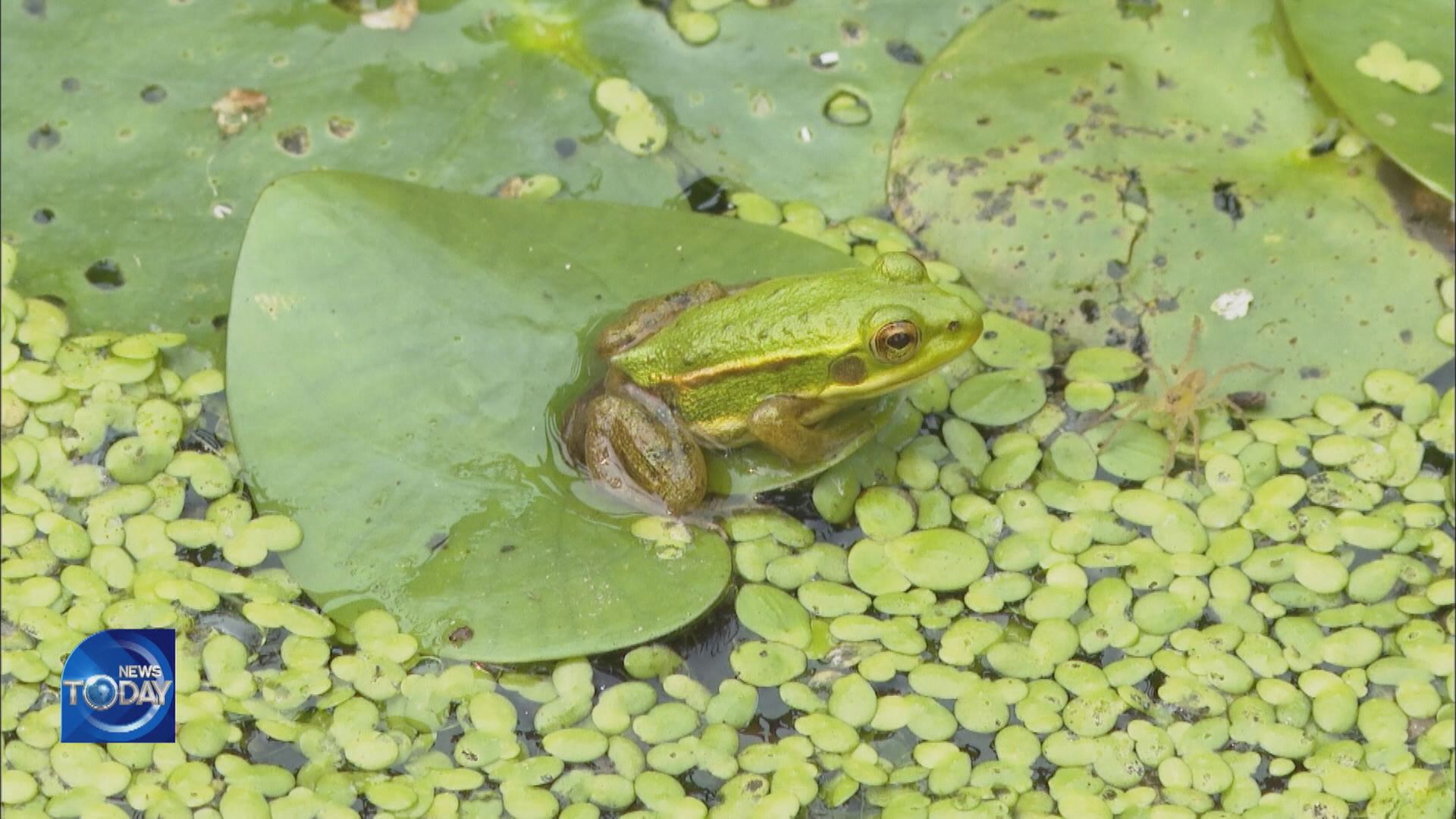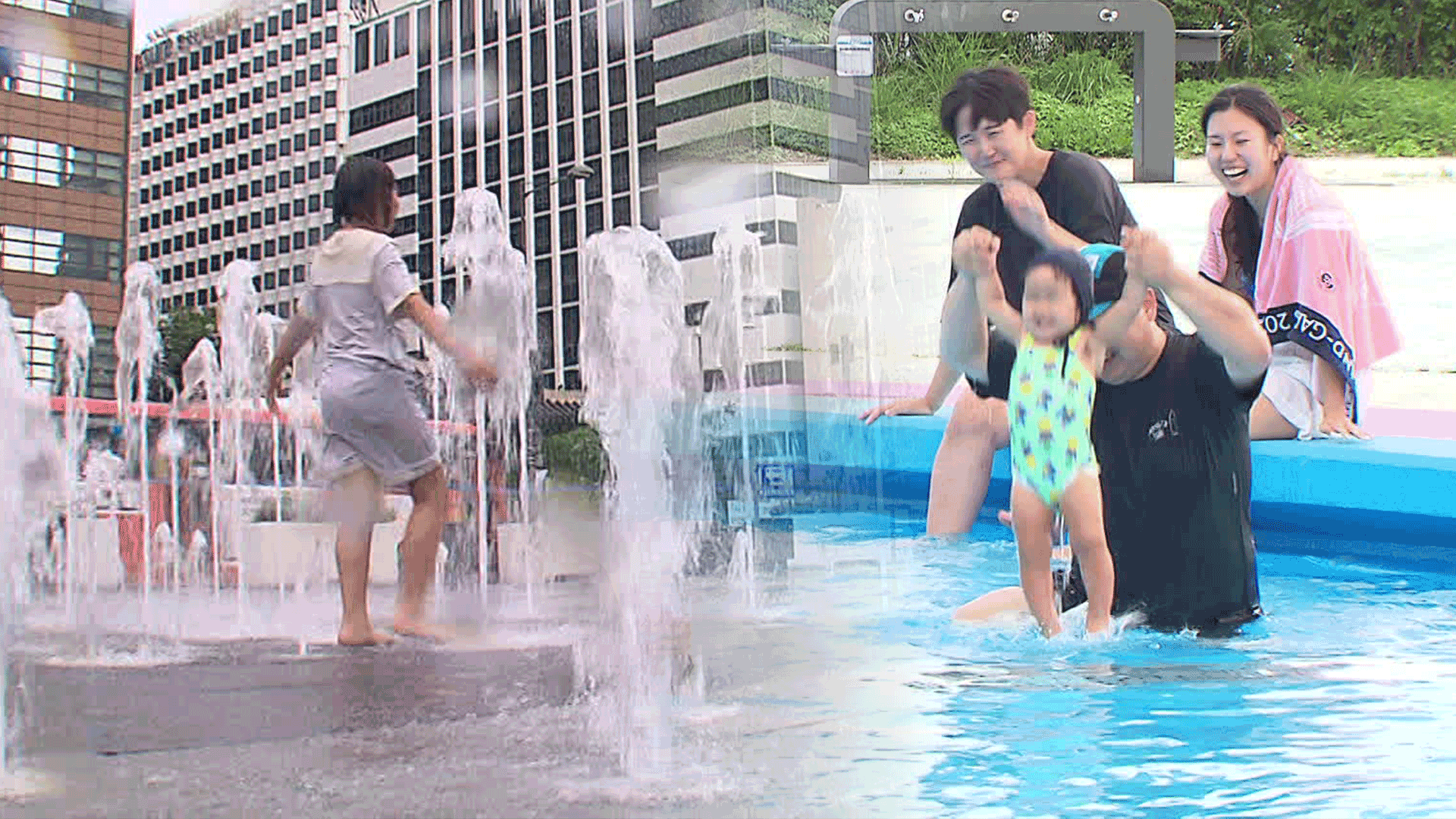ARTIFICIAL BREEDING OF ENDANGERED FROG
입력 2021.08.03 (15:30)
수정 2021.08.03 (16:48)
읽어주기 기능은 크롬기반의
브라우저에서만 사용하실 수 있습니다.
[Anchor Lead]
An endangered species of frogs live in a naturally formed swamp near the Gyeongancheon Stream, a branch of the Hangang River. An artificial breeding project is under way in Hwingseong, Gangwon-do Province, to protect the Seoul pond frogs, which are vulnerable to environmental changes caused by urbanization and water pollution.
[Pkg]
A frog with a clear brownish line along its back. This is a Seoul pond frog. It is categorized as a grade-two endangered species, as its scope of activity is narrower than that of other amphibians and it is especially vulnerable to environmental changes.
[Soundbite] Hong Heung-sook(Ecological expert) : "Leopard frogs have a pair of vocal sacs, while green frogs have one. Seoul pond frogs hardly croak with imperfect vocal sacs."
The swamp in the Gyeongancheon Stream is one of the few habitats for Seoul pond frogs in the capital area. But it is not easy to protect the frogs in the region, due to their low rate of natural hatching and the influx of human population amid city developments. This is why an ecological institute in Hoengseong, Gangwon-do Province, is working to artificially increase the number of Seoul pond frogs. For the project, the facility collected ten pairs of the frogs.
[Soundbite] Lee Kang-un(Holoce Ecosystem Conservation Research Institute) : "Three pairs spawned some 1,000 eggs again. But only 20-30 percent of them were hatched and there are now 200 tadpoles."
With the goal to raise the hatching rate to 20 percent, the institute plans to gradually release adult frogs into the Gyeongancheon starting next summer.
[Soundbite] Shin Dong-heon(Gwangju Mayor) : "We will increase water plants to provide a good home to the frogs in the Gyeongancheon Stream. We will also continue to monitor the number of the frogs and the environment."
In collaboration with local governments, the Ministry of Environment also plans to improve the quality of water and the ecosystem in the stream to grade B from the current grade D. The upgraded level would indicate a relatively 'good' environment for the frogs.
An endangered species of frogs live in a naturally formed swamp near the Gyeongancheon Stream, a branch of the Hangang River. An artificial breeding project is under way in Hwingseong, Gangwon-do Province, to protect the Seoul pond frogs, which are vulnerable to environmental changes caused by urbanization and water pollution.
[Pkg]
A frog with a clear brownish line along its back. This is a Seoul pond frog. It is categorized as a grade-two endangered species, as its scope of activity is narrower than that of other amphibians and it is especially vulnerable to environmental changes.
[Soundbite] Hong Heung-sook(Ecological expert) : "Leopard frogs have a pair of vocal sacs, while green frogs have one. Seoul pond frogs hardly croak with imperfect vocal sacs."
The swamp in the Gyeongancheon Stream is one of the few habitats for Seoul pond frogs in the capital area. But it is not easy to protect the frogs in the region, due to their low rate of natural hatching and the influx of human population amid city developments. This is why an ecological institute in Hoengseong, Gangwon-do Province, is working to artificially increase the number of Seoul pond frogs. For the project, the facility collected ten pairs of the frogs.
[Soundbite] Lee Kang-un(Holoce Ecosystem Conservation Research Institute) : "Three pairs spawned some 1,000 eggs again. But only 20-30 percent of them were hatched and there are now 200 tadpoles."
With the goal to raise the hatching rate to 20 percent, the institute plans to gradually release adult frogs into the Gyeongancheon starting next summer.
[Soundbite] Shin Dong-heon(Gwangju Mayor) : "We will increase water plants to provide a good home to the frogs in the Gyeongancheon Stream. We will also continue to monitor the number of the frogs and the environment."
In collaboration with local governments, the Ministry of Environment also plans to improve the quality of water and the ecosystem in the stream to grade B from the current grade D. The upgraded level would indicate a relatively 'good' environment for the frogs.
■ 제보하기
▷ 카카오톡 : 'KBS제보' 검색, 채널 추가
▷ 전화 : 02-781-1234, 4444
▷ 이메일 : kbs1234@kbs.co.kr
▷ 유튜브, 네이버, 카카오에서도 KBS뉴스를 구독해주세요!
- ARTIFICIAL BREEDING OF ENDANGERED FROG
-
- 입력 2021-08-03 15:30:09
- 수정2021-08-03 16:48:04

[Anchor Lead]
An endangered species of frogs live in a naturally formed swamp near the Gyeongancheon Stream, a branch of the Hangang River. An artificial breeding project is under way in Hwingseong, Gangwon-do Province, to protect the Seoul pond frogs, which are vulnerable to environmental changes caused by urbanization and water pollution.
[Pkg]
A frog with a clear brownish line along its back. This is a Seoul pond frog. It is categorized as a grade-two endangered species, as its scope of activity is narrower than that of other amphibians and it is especially vulnerable to environmental changes.
[Soundbite] Hong Heung-sook(Ecological expert) : "Leopard frogs have a pair of vocal sacs, while green frogs have one. Seoul pond frogs hardly croak with imperfect vocal sacs."
The swamp in the Gyeongancheon Stream is one of the few habitats for Seoul pond frogs in the capital area. But it is not easy to protect the frogs in the region, due to their low rate of natural hatching and the influx of human population amid city developments. This is why an ecological institute in Hoengseong, Gangwon-do Province, is working to artificially increase the number of Seoul pond frogs. For the project, the facility collected ten pairs of the frogs.
[Soundbite] Lee Kang-un(Holoce Ecosystem Conservation Research Institute) : "Three pairs spawned some 1,000 eggs again. But only 20-30 percent of them were hatched and there are now 200 tadpoles."
With the goal to raise the hatching rate to 20 percent, the institute plans to gradually release adult frogs into the Gyeongancheon starting next summer.
[Soundbite] Shin Dong-heon(Gwangju Mayor) : "We will increase water plants to provide a good home to the frogs in the Gyeongancheon Stream. We will also continue to monitor the number of the frogs and the environment."
In collaboration with local governments, the Ministry of Environment also plans to improve the quality of water and the ecosystem in the stream to grade B from the current grade D. The upgraded level would indicate a relatively 'good' environment for the frogs.
An endangered species of frogs live in a naturally formed swamp near the Gyeongancheon Stream, a branch of the Hangang River. An artificial breeding project is under way in Hwingseong, Gangwon-do Province, to protect the Seoul pond frogs, which are vulnerable to environmental changes caused by urbanization and water pollution.
[Pkg]
A frog with a clear brownish line along its back. This is a Seoul pond frog. It is categorized as a grade-two endangered species, as its scope of activity is narrower than that of other amphibians and it is especially vulnerable to environmental changes.
[Soundbite] Hong Heung-sook(Ecological expert) : "Leopard frogs have a pair of vocal sacs, while green frogs have one. Seoul pond frogs hardly croak with imperfect vocal sacs."
The swamp in the Gyeongancheon Stream is one of the few habitats for Seoul pond frogs in the capital area. But it is not easy to protect the frogs in the region, due to their low rate of natural hatching and the influx of human population amid city developments. This is why an ecological institute in Hoengseong, Gangwon-do Province, is working to artificially increase the number of Seoul pond frogs. For the project, the facility collected ten pairs of the frogs.
[Soundbite] Lee Kang-un(Holoce Ecosystem Conservation Research Institute) : "Three pairs spawned some 1,000 eggs again. But only 20-30 percent of them were hatched and there are now 200 tadpoles."
With the goal to raise the hatching rate to 20 percent, the institute plans to gradually release adult frogs into the Gyeongancheon starting next summer.
[Soundbite] Shin Dong-heon(Gwangju Mayor) : "We will increase water plants to provide a good home to the frogs in the Gyeongancheon Stream. We will also continue to monitor the number of the frogs and the environment."
In collaboration with local governments, the Ministry of Environment also plans to improve the quality of water and the ecosystem in the stream to grade B from the current grade D. The upgraded level would indicate a relatively 'good' environment for the frogs.
이 기사가 좋으셨다면
-
좋아요
0
-
응원해요
0
-
후속 원해요
0















![[단독] 윤석열 정부, ‘대통령실 공사비 미지급’ 피소](/data/news/2025/06/30/20250630_8MRvHk.png)

이 기사에 대한 의견을 남겨주세요.